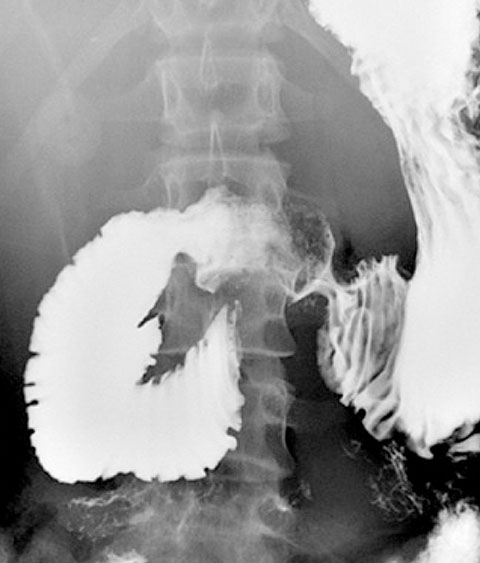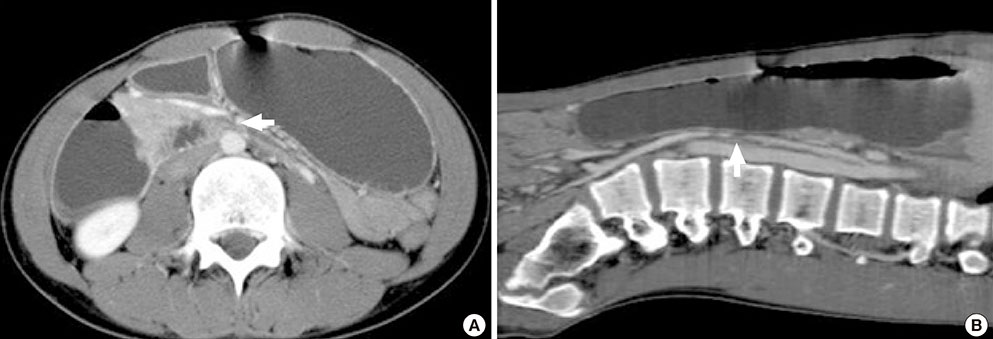J Korean Med Sci.
2013 Aug;28(8):1220-1225. 10.3346/jkms.2013.28.8.1220.
Optimal Duration of Medical Treatment in Superior Mesenteric Artery Syndrome in Children
- Affiliations
-
- 1Department of Pediatrics, College of Medicine, Catholic University of Korea, St. Mary's Hospital, Daejeon, Korea.
- 2Department of Pediatrics, Chungnam National University School of Medicine, Daejeon, Korea. pedkim@cnuh.co.kr
- KMID: 1793029
- DOI: http://doi.org/10.3346/jkms.2013.28.8.1220
Abstract
- The aim of this study was to investigate the outcome, and optimal duration of medical treatment in children with superior mesenteric artery syndrome (SMAS). Eighteen children with SMAS were retrospectively studied. The data reviewed included demographics, presenting symptoms, co-morbid conditions, clinical courses, nutritional status, treatments, and outcomes. The three most common symptoms were postprandial discomfort (67.7%), abdominal pain (61.1%), and early satiety (50%). The median duration of symptoms before diagnosis was 68 days. The most common co-morbid condition was weight loss (50%), followed by growth spurt (22.2%) and bile reflux gastropathy (16.7%). Body mass index (BMI) was normal in 72.2% of the patients. Medical management was successful in 13 patients (72.2%). The median duration of treatment was 45 days. Nine patients (50%) had good outcomes without recurrence, 5 patients (27.8%) had moderate outcomes, and 4 patients (22.2%) had poor outcomes. A time limit of >6 weeks for the duration of medical management tended to be associated with worse outcomes (P=0.018). SMAS often developed in patients with normal BMI or no weight loss. Medical treatment has a high success rate, and children with SMAS should be treated medically for at least 6 weeks before surgical treatment is considered.
MeSH Terms
-
Adolescent
Bile Reflux/diagnosis
Child
Child, Preschool
Demography
Domperidone/therapeutic use
Dopamine Antagonists/therapeutic use
Drug Administration Schedule
Female
Histamine H2 Antagonists/therapeutic use
Humans
Infant
Male
Parenteral Nutrition
Retrospective Studies
Superior Mesenteric Artery Syndrome/*diagnosis/drug therapy
Time Factors
Tomography, X-Ray Computed
Treatment Outcome
Weight Loss
Dopamine Antagonists
Domperidone
Histamine H2 Antagonists
Figure
Reference
-
1. Welsch T, Büchler MW, Kienle P. Recalling superior mesenteric artery syndrome. Dig Surg. 2007; 24:149–156.2. Lippl F, Hannig C, Weiss W, Allescher HD, Classen M, Kurjak M. Superior mesenteric artery syndrome: diagnosis and treatment from the gastroenterologist's view. J Gastroenterol. 2002; 37:640–643.3. Ahmed AR, Taylor I. Superior mesenteric artery syndrome. Postgrad Med J. 1997; 73:776–778.4. Shiu JR, Chao HC, Luo CC, Lai MW, Kong MS, Chen SY, Chen CC, Wang CJ. Clinical and nutritional outcomes in children with idiopathic superior mesenteric artery syndrome. J Pediatr Gastroenterol Nutr. 2010; 51:177–182.5. Biank V, Werlin S. Superior mesenteric artery syndrome in children: a 20-year experience. J Pediatr Gastroenterol Nutr. 2006; 42:522–525.6. Merrett ND, Wilson RB, Cosman P, Biankin AV. Superior mesenteric artery syndrome: diagnosis and treatment strategies. J Gastrointest Surg. 2009; 13:287–292.7. World Health Organisation. Training course on child growth assessment. Geneva: WHO;2008.8. Li J, Chousleb E, Hidalgo J, Patel S, Szomstein S, Rosenthal RJ. Laparoscopic Roux-en-Y duodenojejunal bypass for superior mesenteric artery syndrome: case reports and review of the literature. Surg Laparosc Endosc Percutan Tech. 2011; 21:e344–e347.9. Ha CD, Alvear DT, Leber DC. Duodenal derotation as an effective treatment of superior mesenteric artery syndrome: a thirty-three year experience. Am Surg. 2008; 74:644–653.10. Lee TH, Lee JS, Jo Y, Park KS, Cheon JH, Kim YS, Jang JY, Kang YW. Superior mesenteric artery syndrome: where do we stand today? J Gastrointest Surg. 2012; 16:2203–2211.11. Ozbulbul NI, Yurdakul M, Dedeoglu H, Tola M, Olcer T. Evaluation of the effect of visceral fat area on the distance and angle between the superior mesenteric artery and the aorta. Surg Radiol Anat. 2009; 31:545–549.12. Unal B, Aktaş A, Kemal G, Bilgili Y, Güliter S, Daphan C, Aydinuraz K. Superior mesenteric artery syndrome: CT and ultrasonography findings. Diagn Interv Radiol. 2005; 11:90–95.13. Adson DE, Mitchell JE, Trenkner SW. The superior mesenteric artery syndrome and acute gastric dilatation in eating disorders: a report of two cases and a review of the literature. Int J Eat Disord. 1997; 21:103–114.14. Hines JR, Gore RM, Ballantyne GH. Superior mesenteric artery syndrome: diagnostic criteria and therapeutic approaches. Am J Surg. 1984; 148:630–632.15. Morris TC, Devitt PG, Thompson SK. Laparoscopic duodenojejunostomy for superior mesenteric artery syndrome: how I do it. J Gastrointest Surg. 2009; 13:1870–1873.16. Bermas H, Fenoglio ME. Laparoscopic management of superior mesenteric artery syndrome. JSLS. 2003; 7:151–153.17. Agrawal GA, Johnson PT, Fishman EK. Multidetector row CT of superior mesenteric artery syndrome. J Clin Gastroenterol. 2007; 41:62–65.18. Neri S, Signorelli SS, Mondati E, Pulvirenti D, Campanile E, Di Pino L, Scuderi M, Giustolisi N, Di Prima P, Mauceri B, et al. Ultrasound imaging in diagnosis of superior mesenteric artery syndrome. J Intern Med. 2005; 257:346–351.19. Arthurs OJ, Mehta U, Set PA. Nutcracker and SMA syndromes: what is the normal SMA angle in children? Eur J Radiol. 2012; 81:e854–e861.20. Altiok H, Lubicky JP, DeWald CJ, Herman JE. The superior mesenteric artery syndrome in patients with spinal deformity. Spine (Phila Pa 1976). 2005; 30:2164–2170.21. Lee CS, Mangla JC. Superior mesenteric artery compression syndrome. Am J Gastroenterol. 1978; 70:141–150.22. Lee CW, Park MI, Park SJ, Moon W, Kim HH, Kim BJ, Shim IK, Park SS. A case of superior mesenteric artery syndrome caused by anorexia nervosa. Korean J Gastroenterol. 2011; 58:280–283.23. Jordaan GP, Muller A, Greeff M, Stein DJ. Eating disorder and superior mesenteric artery syndrome. J Am Acad Child Adolesc Psychiatry. 2000; 39:1211.24. Verhoef PA, Rampal A. Unique challenges for appropriate management of a 16-year-old girl with superior mesenteric artery syndrome as a result of anorexia nervosa: a case report. J Med Case Rep. 2009; 3:127.



